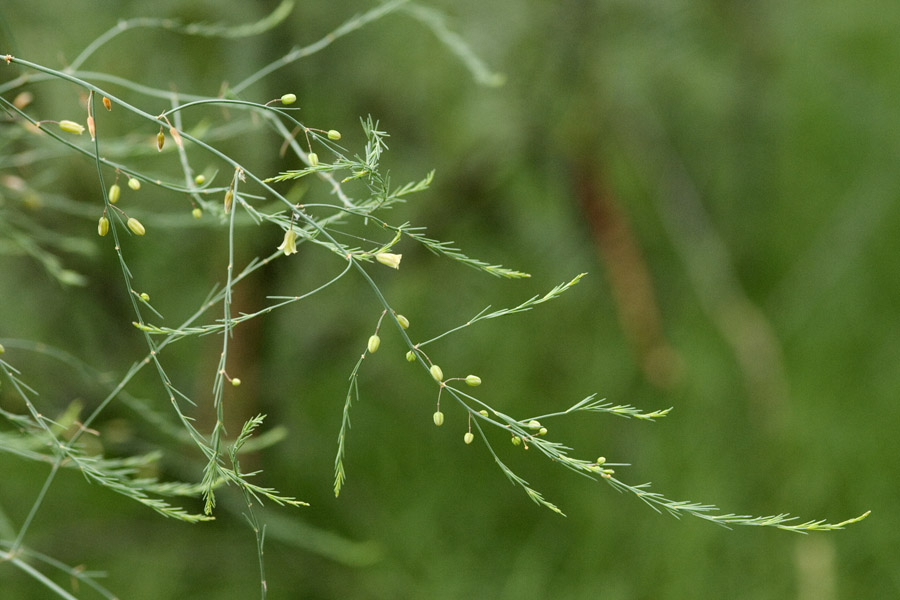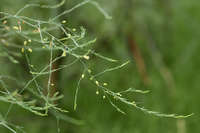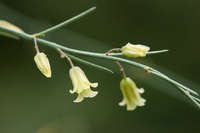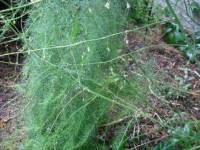Herbs, erect, 1-2.5 m; rhizomes fibrous. Stems annual, densely branched distally; branches finely dissected, ascending to perpendicular, unarmed; cladophylls in clusters of (2-)4-15(-25) per node, filiform, straight or curved, 1-3 cm. Leaves scalelike, 3-4 mm; blade lanceolate, base hardened. Inflorescences in axillary racemes, 1-3-flowered. Flowers some unisexual; perianth campanulate, yellow or yellowish green; tepals connate 1-2 mm, greenish white, 3-8 × 1-2 mm; pedicel 8-12 mm, jointed at or above middle. Berries red, 6-10 mm. Seeds 2-4. 2n = 20, 40.
Flowering summer. Fields, fencerows, roadsides, disturbed areas; 0--2500 m; introduced; St. Pierre and Miquelon; Alta., B.C., Man., N.B., Nfld. and Labr., N.S., Ont., P.E.I., Que., Sask.; Ala., Ariz., Ark., Calif., Colo., Conn., Del., D.C., Fla., Ga., Idaho, Ill., Ind., Iowa, Kans., Ky., La., Maine, Md., Mass., Mich., Minn., Miss., Mo., Mont., Nebr., Nev., N.H., N.J., N.Mex., N.Y., N.C., N.Dak., Ohio, Okla., Oreg., Pa., R.I., S.C., S.Dak., Tenn., Tex., Utah, Vt., Va., Wash., W.Va., Wis., Wyo.; Europe; Asia; n Africa; naturalized in temperate regions worldwide.
Eaten as a vegetable, Asparagus officinalis has been widely cultivated for its young shoots since ancient Greek times. The species is naturalized in many temperate climates. Mature asparagus has caused poisoning in cattle (J. M. Kingsbury 1964). Young plants can cause dermatitis, and the red berries are suspected of poisoning humans (E. M. Schmutz and L. B. Hamilton 1979). The species is dioecious (J. E. Lazarte and B. F. Palser 1979), and homomorphic sex chromosomes have been identified (H. Loptien 1979).
Perennial herb with a short rhizome 1 - 2.5 m tall
Stem: upright and freely branched.
Leaves: reduced to scales that are inconspicuous.
Flowers: one to three, arising from nodes, on 8 - 12 mm long stalks, greenish white, 3 - 5 mm long, bell-shaped, with six tepals. Stamens six.
Fruit: a red berry, 6 - 10 mm long.
Branches: ascending to perpendicular, 1 - 3 cm long, with thread-like (filiform) branchlets.
Similar species: Asparagus officinalis is a distinctive escape in the Chicago Region.
Flowering: mid-May to mid-September
Habitat and ecology: Introduced from Europe. A common escape from cultivation found along fences, roads, and railroads. Also found under scattered trees, utility wires, and in disturbed areas. It often forms a weedy but fairly stable community with other plants.
Occurence in the Chicago region: non-native
Notes: Birds eat the berries.
Etymology: Asparagus is the Greek word for this plant. Officinalis means "sold in shops; official." This may apply to medicinal, edible, and otherwise useful plants.
Author: The Morton Arboretum
Asparagus has been reported from many counties and I have found it in several. I recall seeing only a few colonies of it, but usually single specimens here and there along roads, railroads, and streams and in fallow grounds and open woodland. We have had it in cultivation for years and I have rarely found a seedling near our cultivated plants but it is sporadic all over our field and orchard and along our fences.
Duration: Perennial
Nativity: Non-Native
Lifeform: Forb/Herb
General: Herbaceous perennials, to 2 m tall, stems stout, densely branched distally, branches finely dissected, plants with fibrous rhizomes.
Leaves: Reduced to scales 3-4 mm long, the foliage represented by 1-several filiform branchlets (known as a cladode) per node in the axils of the scales.
Flowers: Small, greenish-yellow or greenish-white, dioecious, perianth campanulate, 5-6 mm long, the segments nearly distinct, tepals connate, greenish white, 3-8 mm long, 1-2 mm wide, stamens 6, attached to the base of the perianth, with 3 stigmas; flowers nodding, solitary or borne in groups of 1-4 in branch axils.
Fruits: A globose, red berry, 6-10 mm in diameter. Seeds 2-4.
Ecology: Found cultivated and frequently as an escapee, fields, roadsides, fence rows, and disturbed areas, from 0-8,000 ft (0-2438 m); flowering July-August.
Distribution: Introduced to N. Amer. from Europe; south to S. Amer.; also in Asia and Africa.
Notes: Look to the slender stalks and scale-like leaves with filiform branchlets to help identify this plant. It has been widely cultivated for its young shoots since ancient Greek times, is now naturalized in many regions, and the young shoots can be eaten as a vegetable. Mature asparagus, on the other hand, has been known to poison cattle, young plants cause dermatitis, and the red berries are suspected of poisoning humans.
Ethnobotany: An infusion of the plant taken for rickets, a compound decoction with the roots used as a foot soak for rheumatism, a compound decoction with bark taken before meals for the blood, and the stalks used for rheumatism. The stalks were also eaten as greens in the spring.
Etymology: Asparagus is an ancient Greek name, while officinalis means sold as an herb, often applied to plants with real or supposed medicinal qualities.
Synonyms: None
Editor: LCrumbacher 2011, FSCoburn 2015
Perennial from a short rhizome, freely branched, to 2 m; ultimate branchlets filiform, 8-15 mm; pedicels solitary or paired, lateral, 5-10 mm, jointed at the middle; fls greenish-white, campanulate, 3-5 mm; berry red, 8 mm; 2n=20, 40. Native of Europe, escaped from cult. into waste places or along salt marshes. May, June.
Gleason, Henry A. & Cronquist, Arthur J. 1991. Manual of vascular plants of northeastern United States and adjacent Canada. lxxv + 910 pp.
©The New York Botanical Garden. All rights reserved. Used by permission.








